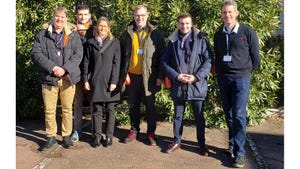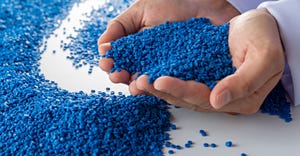Solvay Engineering Plastics introduces PA6 for additive manufacturing
Additive manufacturing for end-use parts is seeing increased demand due to fast lead-times and reduced costs to manufacture low-volume components with engineering properties near or at the levels of injection molded parts. Nylon has long been a popular engineering resin for its properties of strength, chemical and heat resistance, particularly in automotive underhood applications.
September 16, 2013
The development of engineering polymer materials adapted to additive manufacturing, also known as 3D printing, has resulted in many new materials, thus expanding the capability of building end-use parts without the need for molds or injection molding. Solvay Engineering Plastics has developed its PA6 for Selected Laser Sintering, Sinterline, a polyamide 6 powder “that provides a variety of engineering and mechanical properties that are comparable to PA6,” Ralph Risse, Sinterline Marketing Innovation Manager for Sinterline, told PlasticsToday. “So, if you are thinking about rapid prototyping or production parts, you can now get them in nylon.”
Solvay’s Steve Penny, North American product engineering manager and Business Development for Sinterline, added, “The end goal is to see end-use parts in nylon, so we’re just bringing Sinterline to the market. It has higher properties than PA11 and PA12.”
Risse noted that there is a big potential for applications in the automotive aftermarket, particularly truck and heavy-duty vehicles where volumes are lower. “The market focus we are developing is having a product that can extend product life, and additive manufacturing offers a more cost-effective solution because of lower volumes,” Risse said. “For example, motorsport racing and ATVs offer opportunities. All these applications make a lot of sense in the aftermarket. We can also meet the requirements for applications where engine components need replacements.”
Solvay (www.solvay.com) has experience in the vehicle aftermarket making parts used in the 24-hour du Mans Moto – Endurance World Championship race last September where the company made AM parts from Sinterline that withstand the rigors of motorcycle racing. “Why this interest?” queries Risse. “Due to the high temperatures of the engine and the complex configuration and thickness the parts require. Sinterline proved to be ideal.”
The objective of testing Sinterline in the du Mans was to test the equipment’s durability, and to gain time by limiting stops to change the oil, refuel and repair damage. With Sinterline powder and AM technology, a braking system oil container was designed and developed to achieve a 10-second gain per tour for a total of 1 minute 40 seconds. “The properties of Sinterline and Selective Laser Sintering technology open new possibilities of creation,” said Marc Mothre’, team manager for Team Motors Event, in a prepared statement. “With Sinterline we have created parts for the brake system to gain time in the race. It’s also the opportunity change the design of the electronic system plate, allowing us to gain time in case of a breakdown.”
PA6 from Solvay Engineering Plastics has a tensile modulus of 3360MPa at 23oC/0% HR Sinterline unfilled and of 6010 MPa at 23ºC/)% for Sinterline filled with glass fiber, according to Solvay’s information.
PA6 for additive manufacturing processing is new to the industry, while PA11 & 12 for AM has been around for a few years. “We’re excited to bring these properties of PA6 to applications that need it, not to compete against 11 and 12, but to open up the market to higher properties that PA6 provides,” said Penny. “Additionally PA11 & 12 are niche products, where PA6 is a mainstay that brings properties close to what is normally used in the automotive injection molding industry.”
Penny also noted that the auto aftermarket requires lower cost production. “Going to the SLS process with PA6 they can make parts with different functionality that they may not have made on their own with traditional tooling because of the cost,” Penny said. “With PA6 Sinterline the part can become a reality.”
PA6 also brings benefits to part prototyping as well, Penny pointed out. “We can make a part not only to look at, but can do preform functional testing as well – to see if it functionally works – before going into full-scale production,” he said.
This also offers the advantage of not having to build prototype tooling. “You can save tooling costs and development time by using SLS and Sinterline,” Penny said. “At the end of the day, we’ll still make the tool to produce the high-volume parts requirements, but using Sinterline we can make the part very close to what they’re expecting because it mimics very close the injection material.”
Both Risse and Penny agree. “As we continue to push the limits of additive manufacturing and expand materials and applications, we consider rapid manufacturing versus prototyping,” said Risse.
“The future is about production – about mechanical performance for end-use parts – and closing the bridge between prototyping and production. That’s one of our main focuses,” added Penny.
About the Author(s)
You May Also Like




